- ▶
- Heaters/Source
- ▶
- Agilent Heaters and SensorsMass Spectrometry, Scientific Supplies & ManufacturingScientific Instrument Services 5973 Source Heater Tamper Resistant Allen Wrench 5973/5975 Quad Sensor 5985 Source Heater Assembly Agilent Interface Heater Assembly 5971 Interface Heater

- ▶
- TD
- ▶
- AccessoriesTD Supply Kit Desorption Tubes Adsorbent Resins Desorption Tube Needles Desorption Tube Seals Desorption System Fittings GC Cryo-Trap Extraction Cell TD Sample Loader Prepacked, Conditioned Desorption Tubes Desorption Tube Packing Accessories Stainless Steel Purge Heads Injection Port Liners Tenax TA Poster TD Application Notes Customer Service

- LiteratureApplication Notes Adsorbent Resins Guide Mass Spec Tips SDS Sheets FAQ MS Calibration Compound Spectra Manuals MS Links/Labs/ Organizations MS Online Tools Flyers on Products/Services Scientific Supplies Catalog About Us NextAdvance Bullet Blender® Homogenizer Protocols Micro-Mesh® Literature Instrumentation Literature Agilent GC/MS Literature SIS News / E-Mail Newsletter NIST MS Database - Update Notifications

- ▶
- Application NotesNote 103: EPA Method 325B, Novel Thermal Desorption Instrument Modification to Improve Sensitivity Note 102: Identification of Contaminants in Powdered Beverages by Direct Extraction Thermal Desorption GC/MS Note 101: Identification of Contaminants in Powdered Foods by Direct Extraction Thermal Desorption GC/MS Note 100: Volatile and Semi-Volatile Profile Comparison of Whole Versus Cracked Versus Dry Homogenized Barley Grains by Direct Thermal Extraction Note 99: Volatile and Semi-Volatile Profile Comparison of Whole vs. Dry Homogenized Wheat, Rye and Barley Grains by Direct Thermal Extraction GC/MS Note 98: Flavor and Aroma Profiles of Truffle Oils by Thermal Desorption GC/MS Note 97: Flavor Profiles of Imported and Domestic Beers by Purge & Trap Thermal Desorption GC/MS Note 96: Reducing Warping in Mass Spectrometer Filaments, with SISAlloy® Yttria/Rhenium Filaments Note 95: Detection of Explosives on Clothing Material by Direct and AirSampling Thermal Desorption GC/MS Note 94: Detection of Nepetalactone in the Nepeta Cataria Plant by Thermal Desorption GC/MS Note 93: Detection of Benzene in Carbonated Beverages with Purge & Trap Thermal Desorption GC/MS Note 92: Yttria Coated Mass Spectrometer Filaments Note 91: AutoProbe DEP Probe Tip Temperatures Note 90: An Automated MS Direct Probe for use in an Open Access Environment Note 89: Quantitation of Organics via a Mass Spectrometer Automated Direct Probe Note 88: Analysis of Silicone Contaminants on Electronic Components by Thermal Desorption GC-MS Note 87: Design and Development of an Automated Direct Probe for a Mass Spectrometer Note 86: Simulation of a Unique Cylindrical Quadrupole Mass Analyzer Using SIMION 7.0. Note 85: Replacing an Electron Multiplier in the Agilent (HP) 5973 MSD Note 84: Vacuum Pump Exhaust Filters - Charcoal Exhaust Traps Note 83: Vacuum Pump Exhaust Filters - Oil Mist Eliminators Note 82: Vacuum Pump Exhaust Filters Note 81: Rapid Bacterial Chemotaxonomy By DirectProbe/MSD Note 80: Design, Development and Testing of a Microprocessor ControlledAutomated Short Path Thermal Desorption Apparatus Note 79: Volatile Organic Compounds From Electron Beam Cured and Partially Electron Beam Cured Packaging Using Automated Short Path Thermal Desorption Note 78: A New Solution to Eliminate MS Down-Time With No-Tool-Changing of Analytical GC Columns Note 77: The Determination of Volatile Organic Compounds in VacuumSystem Components Note 76: Determination of the Sensitivity of a CRIMS System Note 75: An Apparatus for Sampling Volatile Organics From LivePlant Material Using Short Path Thermal Desorption Note 74: Examination of Source Design in Electrospray-TOF Using SIMION 3D Note 73: The Analysis of Perfumes and their Effect on Indoor Air Pollution Note 72: 1998 Version of the NIST/EPA/NIH Mass Spectral Library, NIST98 Note 71: Flavor Profile Determination of Rice Samples Using Shor tPath Thermal Desorption GC Methods Note 70: Application of SIMION 6.0 To a Study of the Finkelstein Ion Source: Part II Note 69: Application of SIMION 6.0 To a Study of the Finkelstein Ion Source: Part 1 Note 68: Use of a PC Plug-In UV-Vis Spectrometer To Monitor the Plasma Conditions In GC-CRIMS Note 67: Using Chemical Reaction Interface Mass Spectrometry (CRIMS) To Monitor Bacterial Transport In In Situ Bioremediation Note 66: Probe Tip Design For the Optimization of Direct Insertion Probe Performance Note 65: Determination of Ethylene by Adsorbent Trapping and Thermal Desorption - Gas Chromatography Note 64: Comparison of Various GC/MS Techniques For the Analysis of Black Pepper (Piper Nigrum) Note 63: Determination of Volatile and Semi-Volatile Organics in Printer Toners Using Thermal Desorption GC Techniques Note 62: Analysis of Polymer Samples Using a Direct Insertion Probe and EI Ionization Note 61: Analysis of Sugars Via a New DEP Probe Tip For Use With theDirect Probe On the HP5973 MSD Note 60: Programmable Temperature Ramping of Samples Analyzed ViaDirect Thermal Extraction GC/MS Note 59: Computer Modeling of a TOF Reflectron With Gridless Reflector Using SIMION 3D Note 58: Direct Probe Analysis and Identification of Multicomponent Pharmaceutical Samples via Electron Impact MS Note 57: Aroma Profiles of Lavandula species Note 56: Mass Spec Maintenance & Cleaning Utilizing Micro-Mesh® Abrasive Sheets Note 55: Seasonal Variation in Flower Volatiles Note 54: Identification of Volatile Organic Compounds in Office Products Note 53: SIMION 3D v6.0 Ion Optics Simulation Software Note 52: Computer Modeling of Ion Optics in Time-of-Flight mass Spectrometry Using SIMION 3D Note 51: Development and Characterization of a New Chemical Reaction Interface for the Detection of Nonradioisotopically Labeled Analytes Using Mass Spectrometry (CRIMS) Note 50: The Analysis of Multiple Component Drug Samples Using a Direct Probe Interfaced to the HP 5973 MSD Note 49: Analysis of Cocaine Utilizing a New Direct Insertion Probe on a Hewlett Packard 5973 MSD Note 48: Demonstration of Sensitivity Levels For the Detection of Caffeine Using a New Direct Probe and Inlet for the HP 5973 MSD Note 47: The Application Of SIMION 6.0 To Problems In Time-of-Flight Mass Spectrometry Note 46: Delayed Extraction and Laser Desorption: Time-lag Focusing and Beyond Note 45: Application of SIMION 6.0 to Filament Design for Mass Spectrometer Ionization Sources Note 44: The Design Of a New Direct Probe Inlet For a Mass Spectrometer Note 43: Volatile Organic Composition In Blueberries Note 42: The Influence of Pump Oil Purity on Roughing Pumps Note 41: Hydrocarbon Production in Pine by Direct Thermal Extraction Note 40: Comparison of Septa by Direct Thermal Extraction Note 39: Comparison of Sensitivity Of Headspace GC, Purge and Trap Thermal Desorption and Direct Thermal Extraction Techniques For Volatile Organics Note 38: A New Micro Cryo-Trap For Trapping Of Volatiles At the Front Of a GC Capillary Column Note 37: Volatile Organic Emissions from Automobile Tires Note 36: Identification Of Volatile Organic Compounds In a New Automobile Note 35: Volatile Organics Composition of Cranberries Note 34: Selection Of Thermal Desorption and Cryo-Trap Parameters In the Analysis Of Teas Note 33: Changes in Volatile Organic Composition in Milk Over Time Note 32: Selection and Use of Adsorbent Resins for Purge and Trap Thermal Desorption Applications Note 31: Volatile Organic Composition in Several Cultivars of Peaches Note 30: Comparison Of Cooking Oils By Direct Thermal Extraction and Purge and Trap GC/MS Note 29: Analysis Of Volatile Organics In Oil Base Paints By Automated Headspace Sampling and GC Cryo-Focusing Note 28: Analysis Of Volatile Organics In Latex Paints By Automated Headspace Sampling and GC Cryo-Focusing Note 27: Analysis of Volatile Organics In Soils By Automated Headspace GC Note 26: Volatile Organics Present in Recycled Air Aboard a Commercial Airliner Note 25: Flavor and Aroma in Natural Bee Honey Note 24: Selection of GC Guard Columns For Use With the GC Cryo-Trap Note 23: Frangrance Qualities in Colognes Note 22: Comparison Of Volatile Compounds In Latex Paints Note 21: Detection and Identification Of Volatile and Semi-Volatile Organics In Synthetic Polymers Used In Food and Pharmaceutical Packaging Note 20: Using Direct Thermal Desorption to Assess the Potential Pool of Styrene and 4-Phenylcyclohexene In Latex-Backed Carpets Note 19: A New Programmable Cryo-Cooling/Heating Trap for the Cryo-Focusing of Volatiles and Semi-Volatiles at the Head of GC Capillary Columns Note 18: Determination of Volatile Organic Compounds In Mushrooms Note 17: Identification of Volatile Organics in Wines Over Time Note 16: Analysis of Indoor Air and Sources of Indoor Air Contamination by Thermal Desorption Note 14: Identification of Volatiles and Semi-Volatiles In Carbonated Colas Note 13: Identification and Quantification of Semi-Volatiles In Soil Using Direct Thermal Desorption Note 12: Identification of the Volatile and Semi-Volatile Organics In Chewing Gums By Direct Thermal Desorption Note 11: Flavor/Fragrance Profiles of Instant and Ground Coffees By Short Path Thermal Desorption Note 10: Quantification of Naphthalene In a Contaminated Pharmaceutical Product By Short Path Thermal Desorption Note 9: Methodologies For the Quantification Of Purge and Trap Thermal Desorption and Direct Thermal Desorption Analyses Note 8: Detection of Volatile Organic Compounds In Liquids Utilizing the Short Path Thermal Desorption System Note 7: Chemical Residue Analysis of Pharmaceuticals Using The Short Path Thermal Desorption System Note 6: Direct Thermal Analysis of Plastic Food Wraps Using the Short Path Thermal Desorption System Note 5: Direct Thermal Analysis Using the Short Path Thermal Desorption System Note 4: Direct Analysis of Spices and Coffee Note 3: Indoor Air Pollution Note 2: Detection of Arson Accelerants Using Dynamic Headspace with Tenax® Cartridges Thermal Desorption and Cryofocusing Note 1: Determination of Off-Odors and Other Volatile Organics In Food Packaging Films By Direct Thermal Analysis-GC-MS Tech No. "A" Note 14: Elimination of "Memory" Peaks in Thermal Desorption Improving Sensitivity in the H.P. 5971 MSD and Other Mass Spectrometers - Part I of II Improving Sensitivity in the H.P. 5971 MSD and Other Mass Spectrometers- Part II of II Adsorbent Resins Guide Development and Field Tests of an Automated Pyrolysis Insert for Gas Chromatography. Hydrocarbon Production in Pine by Direct Thermal Extraction A New Micro Cryo-Trap for the Trapping of Volatiles at the Front of a GC Capillary (019P) - Comparison of Septa by Direct Thermal Extraction Volatile Organic Composition in Blueberry Identification of Volatile Organic Compounds in Office Products Detection and Indentification of Volatiles in Oil Base Paintsby Headspace GC with On Column Cryo-Trapping Evaluation of Septa Using a Direct Thermal Extraction Technique INFLUENCE OF STORAGE ON BLUEBERRY VOLATILES Selection of Thermal Desorption and Cryo-Trap Parameters in the Analysis of Teas Redesign and Performance of a Diffusion Based Solvent Removal Interface for LC/MS The Design of a New Direct Probe Inlet for a Mass Spectrometer Analytes Using Mass Spectrometry (CRIMS) Application of SIMION 6.0 to Filament Design for Mass Spectrometer Ionization Sources A Student Guide for SIMION Modeling Software Application of SIMION 6.0 to Problems in Time-of-flight Mass Spectrometry Comparison of Sensitivity of Headspace GC, Purge and TrapThermal Desorption and Direct Thermal Extraction Techniques forVolatile Organics The Influence of Pump Oil Purity on Roughing Pumps Analysis of Motor Oils Using Thermal Desorption-Gas Chromatography-Mass Spectrometry IDENTIFICATION OF VOLATILE ORGANIC COMPOUNDS IN PAPER PRODUCTS Computer Modeling of Ion Optics in Time-of-Flight mass Spectrometry using SIMION 3D Seasonal Variation in Flower Volatiles Development of and Automated Microprocessor Controlled Gas chromatograph Fraction Collector / Olfactometer Delayed Extraction and Laser Desorption: Time-lag Focusing and Beyond A New Micro Cryo-Trap for the Trapping of Volatiles at the Front of a GC Column Design of a Microprocessor Controlled Short Path Thermal Desorption Autosampler Computer Modeling of Ion Optics in Time-of-Flight Mass Spectrometry Using SIMION 3D Thermal Desorption Instrumentation for Characterization of Odors and Flavors

- ▶
- Adsorbent ResinsTenax® TA Adsorbent Resin Tenax®-GR Adsorbent Resin for Trapping Volatiles Carbotrap Adsorbent Resin Physical Properties Carbotrap C Adsorbent Resin Physical Properties Carboxen 569 Adsorbent Resin Physical Properties Carbsieve SIII Adsorbent Resin Physical Properties Glass Beads Adsorbent Resin Physical Properties Determination and Use of Breakthrough Volume Data Tenax® TA Breakthrough Volume Data Tenax® GR Breakthrough Volume Data Carbotrap Breakthrough Volume Data Carbotrap C Breakthrough Volume Data Carboxen 569 Breakthrough Volume Data Carbosieve SIII Breakthrough Volume Data Glass Beads Breakthrough Volume Data Hydrocarbon Breakthrough Volumes for Adsorbent Resins Alcohol Breakthrough Volumes for Adsorbent Resins Alkene Breakthrough Volumes for Adsorbent Resins Acetate and Acid Breakthrough Volumes for Adsorbent Resins Aldehyde and Ketone Breakthrough Volumes for Adsorbent Resins Halogen Breakthrough Volumes for Adsorbent Resins Amine Breakthrough Volumes for Adsorbent Resins Aromatics and Terpenes Breakthrough Volumes for Adsorbent Resins Water Breakthrough Volumes for Adsorbent Resins Tenax® TA Back Pressure Versus Flow Data Tenax® GR Back Pressure Versus Flow Data Carbotrap and Carbotrap C Back Pressure Versus Flow Data Carbosieve SIII Back Pressure Versus Flow Data
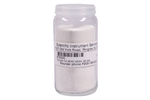
- ▶
- Determination and Use of Breakthrough Volume DataDefinition of Breakthrough Volume Calculation and Use of Breakthrough VolumeData Determination of Breakthrough Volume Example of the Use of Breakthrough Volume Data Determination of Back Pressure Data for Adsorbent Resins How to Select an Adsorbent Resin for an Application Use of Mixed Resin Beds Preparation and Conditioning of Desorption Tubes and ResinBeds Note 32: Selection and Use of Adsorbent Resins for Purge and Trap Thermal Desorption Applications Other References on Adsorbent Resins

- ▶
- Example of the Use of Breakthrough Volume Data (This Page)
Removal of Ethanol from a Wine Sample
In the analysis of wines, the ethanol concentration is greater than 10 percent for most samples with the combined flavor components comprising less than 1 percent of the sample. As a result, if the entire wine sample were analyzed via direct injection or purge and trap of the entire sample, the ethanol peak will be so large that it would overload the capillary column and make the analysis of the trace flavor compounds very difficult. In order to analyze the wine samples for the flavor ingredients, the ethanol must be removed from the sample which can be collected and analyzed via the purge and trap thermal desorption technique.
In the studies below, Tenax® TA was selected as the adsorbent resin. Tenax was selected due to its low affinity for water and for its low breakthrough volumes for methanol and ethanol. Desorption tubes were packed with 100 milligram of Tenax TA and the samples were collected by placing the wine sample (5.0 mL) into a purge and trap tube and purging with pure nitrogen. A complete description of the analysis of wines via this technique is presented in Application Note No. 17. After the sample was collected it was necessary to determine the volumes of gas that would be needed to purge the ethanol from the sample. Breakthrough volumes are typically listed in the units of Liters per gram of resin. Since our collection tubes contain 100 milligram (0.10 grams) of Tenax TA the Breakthrough Volumes for the analytes need to be converted to milliliters per 100 milligram for our application. The breakthrough volumes for methanol, ethanol and several other organic analytes were obtained from the Breakthrough Volume tables and are listed in the table below:
In order to remove the methanol and ethanol from the samples but not remove any of the other flavor components, the purge gas volume must be carefully selected using the data in the table as a guide. The chart below demonstrates what volume of gas is required to remove the methanol and the ethanol.
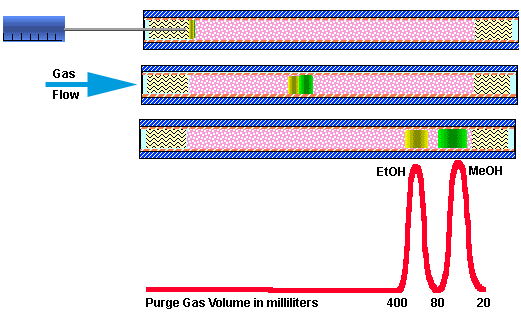
Keep in mind that the Breakthrough Volume Numbers in the table above correspond to the top of a GC peak. The compounds eluting off the adsorbent resin bed have some width and in order to assure the complete removal of the alcohol, the values must be doubled or tripled. Typically the analyte begins to be eluted off the resin at one half the Breakthrough Volume value and is totally eluted off the resin bed at 2 to 3 times the Breakthrough Volume value. Therefore in order to remove the methanol from the adsorbent resin bed, about 80 milliliters of nitrogen purge gas is required. To remove the ethanol, about 400 to 500 milliliters of nitrogen is required. The "Rule-of-Thumb" of 2 to 3 times the Breakthrough Volume is a good safe bet to remove all of the analyte as will be demonstrated below.
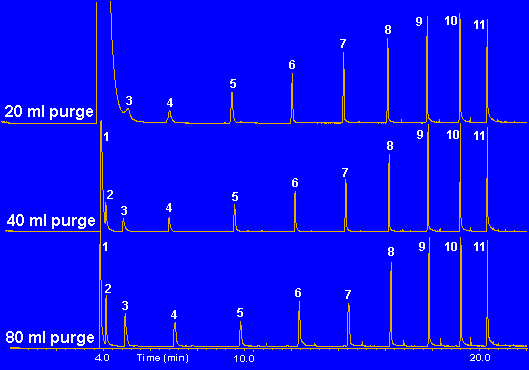
This can be demonstrated quite nicely in the example above of a mixture of alcohols dissolved in methanol at a concentration of 100 ng/ul. One ul of this methanol solution was injected onto the front of a desorption tube and then purged with various volumes of nitrogen in an effort to remove the methanol solvent. Afterwards the desorption tubes were analyzed using the SIS Short Path Thermal Desorption System to desorb the alcohols off the resin and into the GC for analysis. As noted above the Breakthrough volume for methanol is about 36 mL per 100 milligram of Tenax TA at 20 degrees C. Purging with 20 milliliters removes very little of the methanol. Purging with 40 milliliters removes a good portion of the methanol, enough such that the ethanol peak is observable and the propanol is completely resolved from the methanol tailing peak. Increasing the purge flow to 80 milliliter removes most of the methanol and the ethanol and propanol are well resolved. Increasing the purge flow to greater than 100 milliliter would begin to elute the ethanol off the resin, which would not be preferable in this case. Without this purging of the sample after collection, the ethanol and propanol would be impossible to isolate and identify.
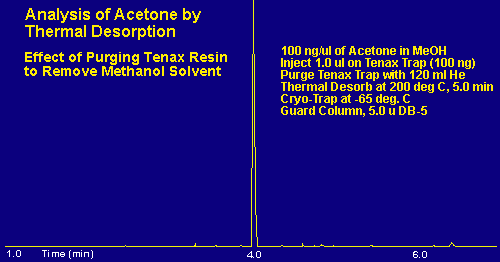
In the example above, a mixture of acetone in methanol solvent was prepared as above and purged with 120 milliliters of nitrogen to remove the methanol. By increasing the purge gas flow to 120 milliliters, the methanol is totally removed from the sample, and 100 percent of the acetone is retained since the breakthrough volume for acetone is 600 mL/100 milligram. Quite often in our analysis of samples we use deuterated internal standards dissolved in methanol solvent in order to quantitate the levels of analytes in our samples. After the sample is collected we inject 1.0 ul of the internal standard in methanol onto the top of the Tenax resin bed and purge the desorption tube with 120 milliliters of nitrogen to totally remove the methanol solvent but retain the internal standard along with the analytes of interest. The samples are subsequently analyzed via the S.I.S. Short Path Thermal Desorption System.
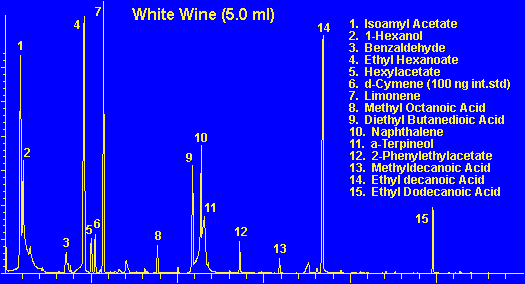
For the analysis of wine samples, we want to purge the ethanol off the collected samples. Since the Breakthrough Volume for Ethanol is 180 mL/100 milligram Tenax TA, we have selected a purge volume of 400 milliliters as our post purge gas volume ( 2 times the Breakthrough Volume). This volume will assure complete removal of the ethanol but most of the flavor component analytes from the wine will be retained for analysis as shown above. This is the method that was used to analyze the wine samples described in Application Note No. 17 and in other wine samples we have analyzed for customers in the wine industry.
The above description demonstrates the use of the breakthrough volume data to purge off solvent fronts or major components from a sample collected on adsorbent resins via the purge and trap technique. After selecting the analytes that you wish to elute from the adsorbent resin bed, looking up its Breakthrough Volume in the tables at the sample collection temperature and then after correcting for the adsorbent resin bed volume and multiplying by 2 you will have determined the amount of nitrogen gas needed to purge the analyte off the adsorbent resin bed.
A more detailed description of Breakthrough Volumes is in the article entitled: "Calculation and Use of Breakthrough Volume Data." and in Application Note 32.

